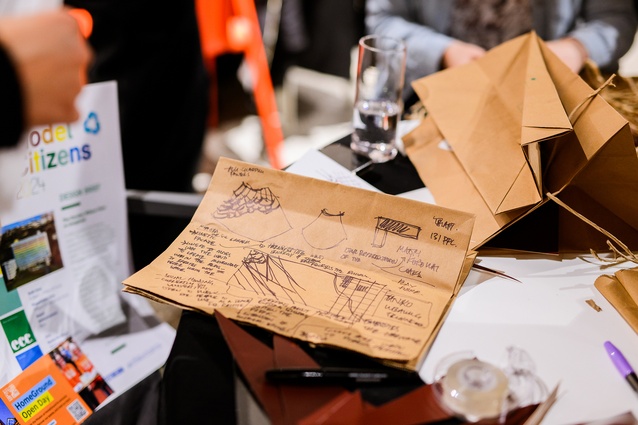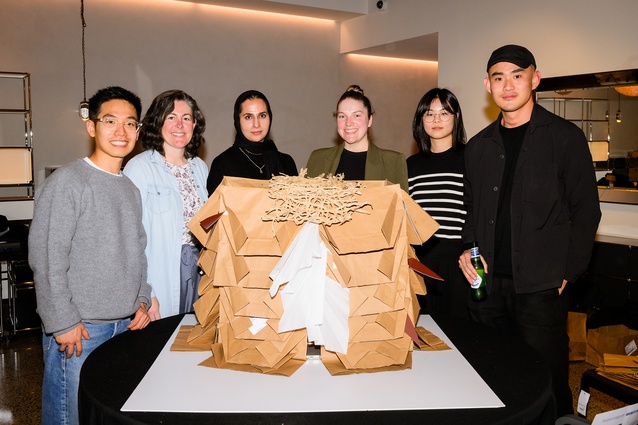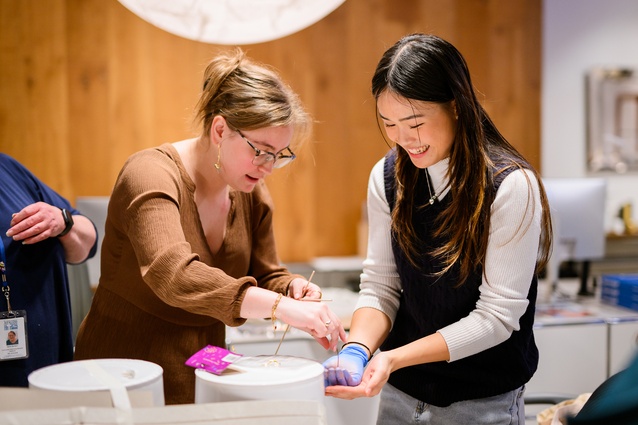Model Citizens repurpose the Gordon Wilson Flats
In 2007, architect Carl Elefante wrote: “The greenest building is the building that is already built.” With this in mind, the mission for this year’s Model Citizens teams was to re-imagine what Wellington’s celebrated Gordon Wilson Flats (1959) could, or should, be.
For those not familiar with the plight of the colourful flats, they were deemed unsafe by Housing New Zealand in 2012, with their 131 social housing tenants given just one week to vacate. In 2014, Victoria University bought the building for around $6 million and in 2016, the Wellington City Council approved the rezoning of the heritage-listed flats, paving the way for the university to demolish them. An appeal to the Environment Court saw their listing stand but in March this year, the Council voted to remove their heritage designation in an update to the district plan.
However, before the vote could be enforced, the Minister for RMA Reform, Hon. Chris Bishop, had to decide whether to accept or reject the recommendation. His ruling, released on 24 May 2024, stated: “There is not sufficient evidence to support the Council’s alternative recommendation to remove the Gordon Wilson Flats from the heritage schedule.” Today, the building remains on the heritage schedule and efforts to see it occupied and become a valued, treasured asset to the city continue.
The brief to this year’s cohort of Model Citizens was therefore:
“The application to remove Wellington’s iconic Gordon Wilson Flats from the Heritage Schedule was, according to some, paving the way for sledgehammers, wrecking balls and climate change issues. With this in mind, we ask you to use your making materials to re-imagine.”
The architects had earlier in the week been asked to use three empty Resene pails to collect and organise building materials from their studios or WFH spaces, such as paper, containers, packaging and excess samples, for use in the making challenge. They were encouraged to gather items that would normally be recycled, as the aim was for a zero-waste event.
On the night, judges Francisco Carbajal (Life Cycle Assessment specialist), Rachel MacIntyre (Strategic Sustainability advisor to Te Kāhui Whaihanga) and Amanda Harkness (Deputy editor Architecture NZ) called for the teams to come up with brave and radical ideas in re-imagining the flats, in response to Wellington’s climate, topographic challenges/advantages and its economic focus on the creative industries.
Armed with their recycling materials and colourful elevations supplied on the night, the teams did not disappoint.
Woods Bagot, having arrived with bags full of paper bags, created a sculpturally beautiful korowai-clad façade to the student and public project, with its kinetic design supplying energy to the building. Inside, a vast, hollowed-out central atrium was lit from the ground level, the intricately woven (from paper bag handles) ceiling at the top casting shadows throughout the space. The project, which honoured the site’s heritage, was awarded “best consideration of matauranga Māori principles in its design”, with a special award for “most likely to be impacted by Wellington’s wind”.
Next up, the team from Architecture+Women produced an almost fun-park reimagining, where it appeared students might have to run the gauntlet between wrecking balls in order to make it to the gondola, which would ferry them safely up the hill to their lectures. Slightly Hunger Games in its representation but literal in its response to brief, the design earned the team the “best integration/response to landscape award”.

Paul Brown & Associates had a run on colour to rival the Hindu Festival of Holi, with their aptly-named Swatch Terraces student flats celebrating the existing building’s famous balconies and, unsurprisingly, earning the team the “best use of colour award”.
The majority of the participants on the night perhaps wished they worked at RTA Studio, whose recycling bins that week had been filled, almost exclusively it would seem, with empty bottles of Moët. We were relieved to hear this was not the norm but rather a celebration of the studio having turned 25 that week. The team created a vessel from the vessels, atop pontoons that would rise and fall with any water inundation that might make it up the hill that far. There was impressive rigour and beauty to this project and a clever presentation technique with a synchronised swaying duet. The project was awarded “most innovative use of materials”.

Next we came to last year’s award holders, SANNZ (the Student Architecture Network of New Zealand), once again led by the inimitable Sahil Tiku. The team had toiled long and hard to resolve Wellington’s water issues, amongst other issues, and the resulting Pōneke Pipe Park took care of water and sewage treatment as well as any quarelling local body and central government politicians. It took out the “best sustainable and/or environmental approach”.
Warren and Mahoney took us all back to our student days, with a super-cool, laid-back community-led (commune-like) approach of coloured floors based on moods and activities, where everything appeared calm and everyone would be at one with each other. It was a place for people, as well as a creative space, with a rooftop club. No surprises then that they took out the “community engagement” award, with a special award for “most likely to cause a community uproar”.

Finally, Respond Architects’ self-sufficient Hauora Home of Regeneration for trauma recovery and healing was a futuristic almost dystopian project, housed within a giant cage-like aviary. The predator-free fence protected a rainforest, waterfalls, birds and fish and, as nature took over, you could imagine flocks of kaka flying in to rest and nest in the building. With its reconnection to nature and support of our ecosystem, the project build was awarded “best biophilic response”.
But, despite all these special awards, there can be only one winner, and edging out the others by mere points, SANNZ came in at the end to take out the big prize along with a beautiful Graypants Wick light for each team member, thanks to the generosity of our sponsor ECC.
In making his acceptance speech, never one to miss an opportunity, Tiku suggested any of the practices in the room might be keen to employ one of the very accomplished student graduates on his twice-winning team. We like his spirit.
Of judging, MacIntyre said she enjoyed meeting so many talented architects and watching their creations appear over such a short timeframe. “If we could approach the challenges we face around climate change, biodiversity loss and the housing crisis in such a collaborative, engaging, accelerated and fun way, we could move mountains.”
She also said she hoped using the Gordon Wilson Flats as the basis of the brief encouraged those who did not know about its history to learn about the building’s heritage and potential future or “non-future”.
“I loved the enthusiasm from the architects as they tackled real-world challenges with creative solutions,” Carbajal said. “In Aotearoa, we need to get better at preserving and repurposing our existing buildings – finding new life for them so they can last another 100 years. This approach not only helps avoid using new embodied carbon in structures but it also makes great use of the carbon already invested in the building. The Model Citizens work shows that repurposing can be creative, fun and an exciting opportunity for the wider community.”
Highlights for Carbajal were “the interesting use of lemon from RTA” and the “act-out reporting presentation by SANNZ”, which included a makeshift bee representing the Parliament building.
A huge thank you to event sponsors ECC for hosting the competition, and Resene and Kingspan for their prizes and support in sponsoring two of the teams. In the spirit of zero waste, each of the teams took their models away with them and disposed of any unused materials in the recycling bin on the way out.
The Architectural Centre is currently engaged in presenting a case for an adaptive reuse scheme for the building that would see it inhabited once more, specifically for post-graduate students at Victoria University of Wellington. See the Centre’s Open Letter addressed to the Hon. Chris Bishop, Minister for RMA Reform.












































